Micrographs of an interesting coin
 jrm
Posts: 24 ✭
jrm
Posts: 24 ✭
For the past fourteen months I've been working on a project and just recently was able to get Electron Microscope Scans of the coin. I would like to present these micrographs, photographs and the story (I've been writing a book) in layers over the next several days. Some days may be bland and others exciting as the coin reveals itself. Over the last year I've learned quite a bit about the minting processes, history and the coin, but I know that there is much more to learn. Please comment and be helpful if you can, hopefully we can all learn something from this. The fist image is of a properly struck portion of the coin taken in the area of the field. The second was taken from a central area of the coin that was unstruck as a result of a large die chip that left the area untouched as original planchet surface. These first two micrographs were taken at fifteen hundred times magnification, that corresponds to a coin that would be over one hundred feet across. I hope you enjoy them.
Jon
Comments
Wow!
Interesting “landscape!”
I think the forum software only takes jpg files if you want pics to show in a thread. Do you want me to try to post them here for you?
Great transactions with oih82w8, JasonGaming, Moose1913.
Converted to jpg.
Thank you, this will be a recurring theme over the next few days.
Hemispherical got it. The pics are interesting.
Great transactions with oih82w8, JasonGaming, Moose1913.
It would be interesting to see the same experiment with proof coins. What coin was used in the above pictures?
Great transactions with oih82w8, JasonGaming, Moose1913.
ms70 the coin is a modern dime, It will reveal itself and its unique nature over the coming days.
Interesting.
So much for the concept of a 70 grade being "Perfect", at least when one views the coin at the micro level provided by this type of microscope.
ms70 was who he was responding to, not the grade of the coin, which wasn't mentioned.
Keeper of the VAM Catalog • Professional Coin Imaging • Prime Number Set • World Coins in Early America • British Trade Dollars • Variety Attribution
Oops.
My bad.
Here is the same well struck area from the first images of the field at one hundred times.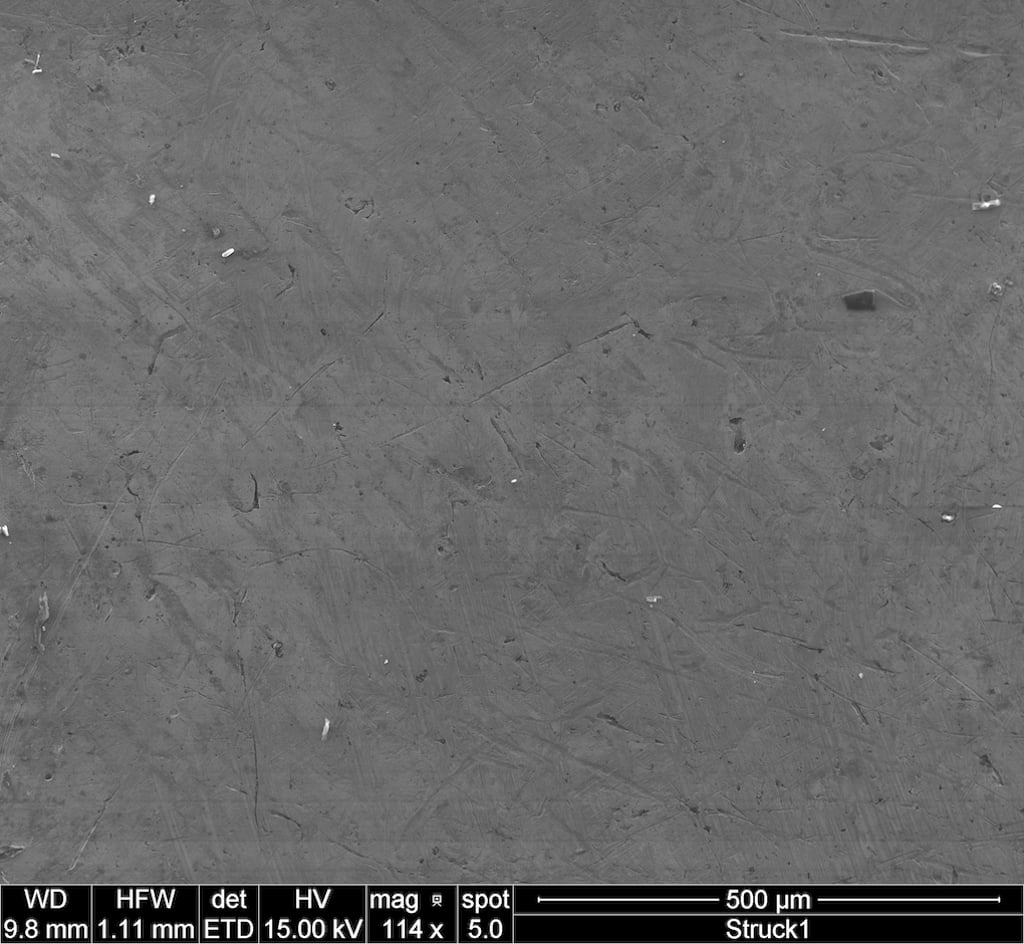
Here is the same unstruck area from the first images at one hundred times.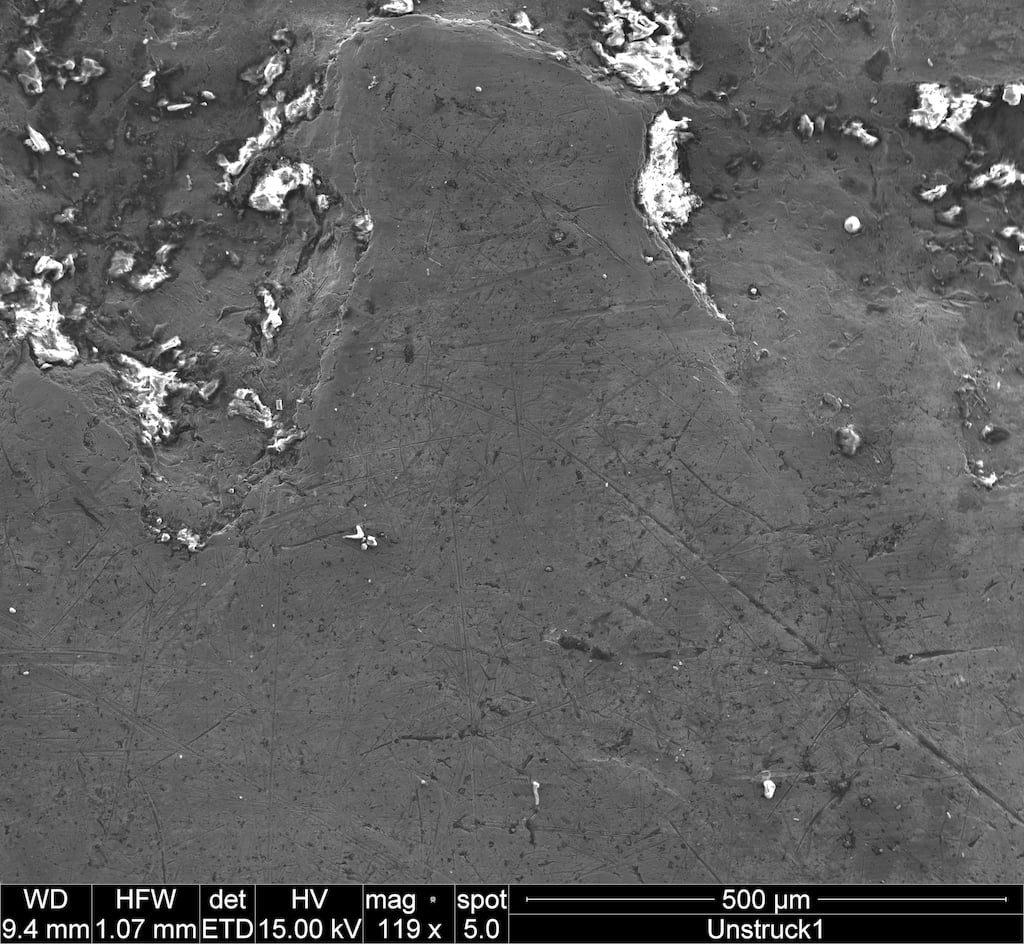
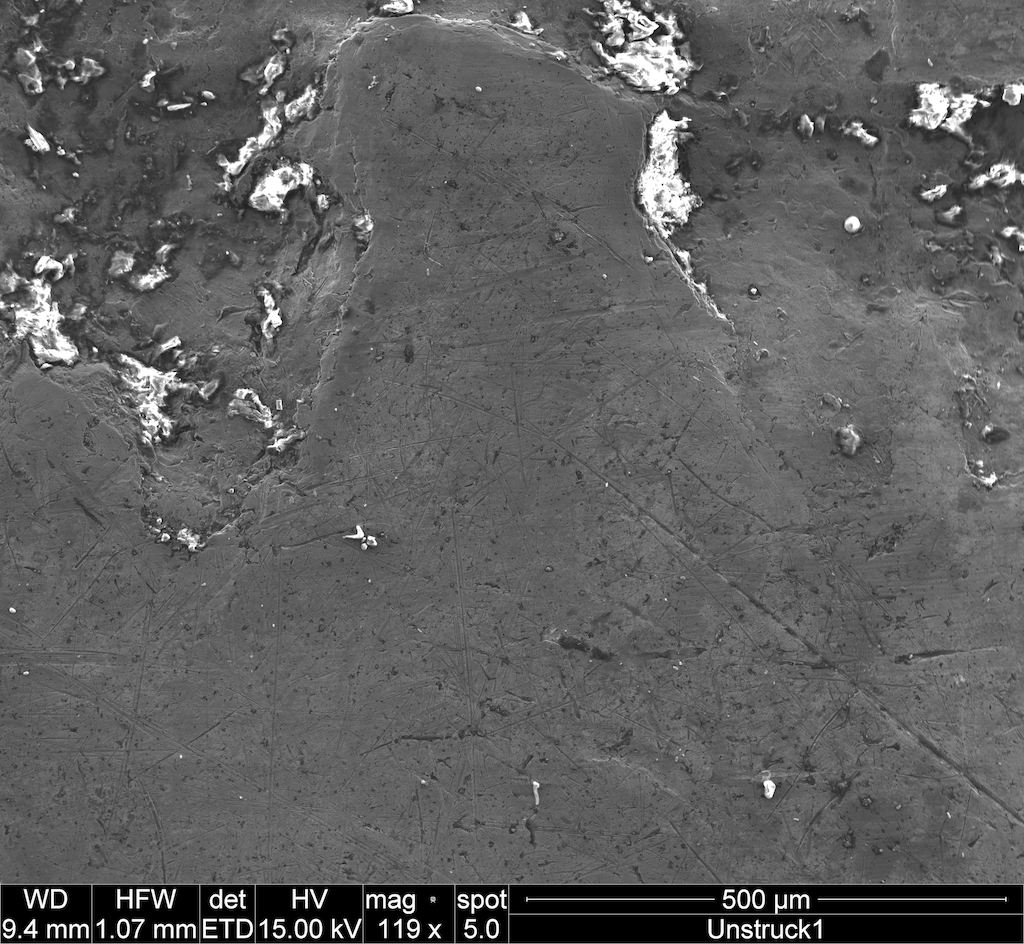
This coin has a lot more to offer. Here are two magnifications of a struck through object (a fragment of die material). The white areas are probably dirt.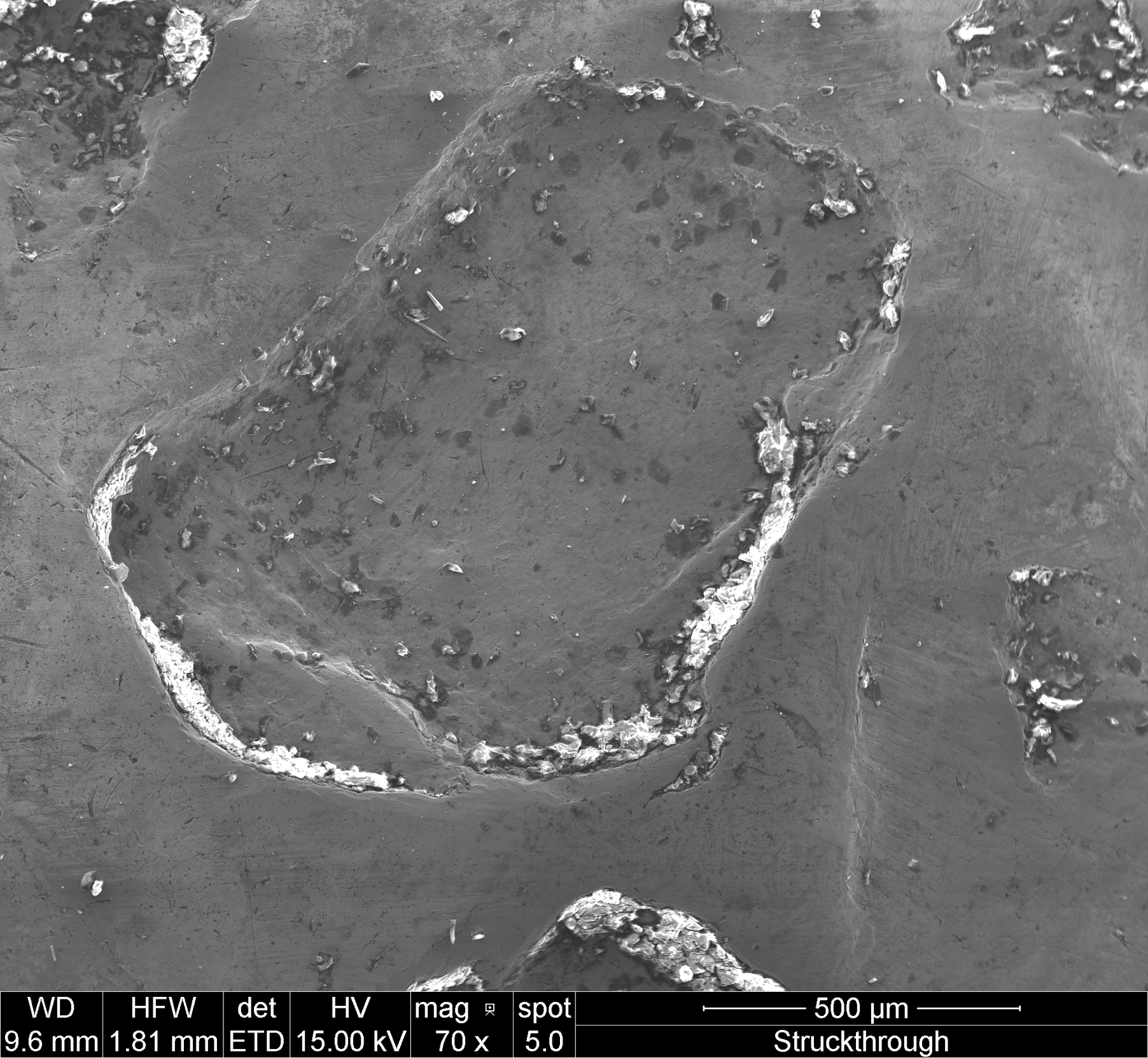
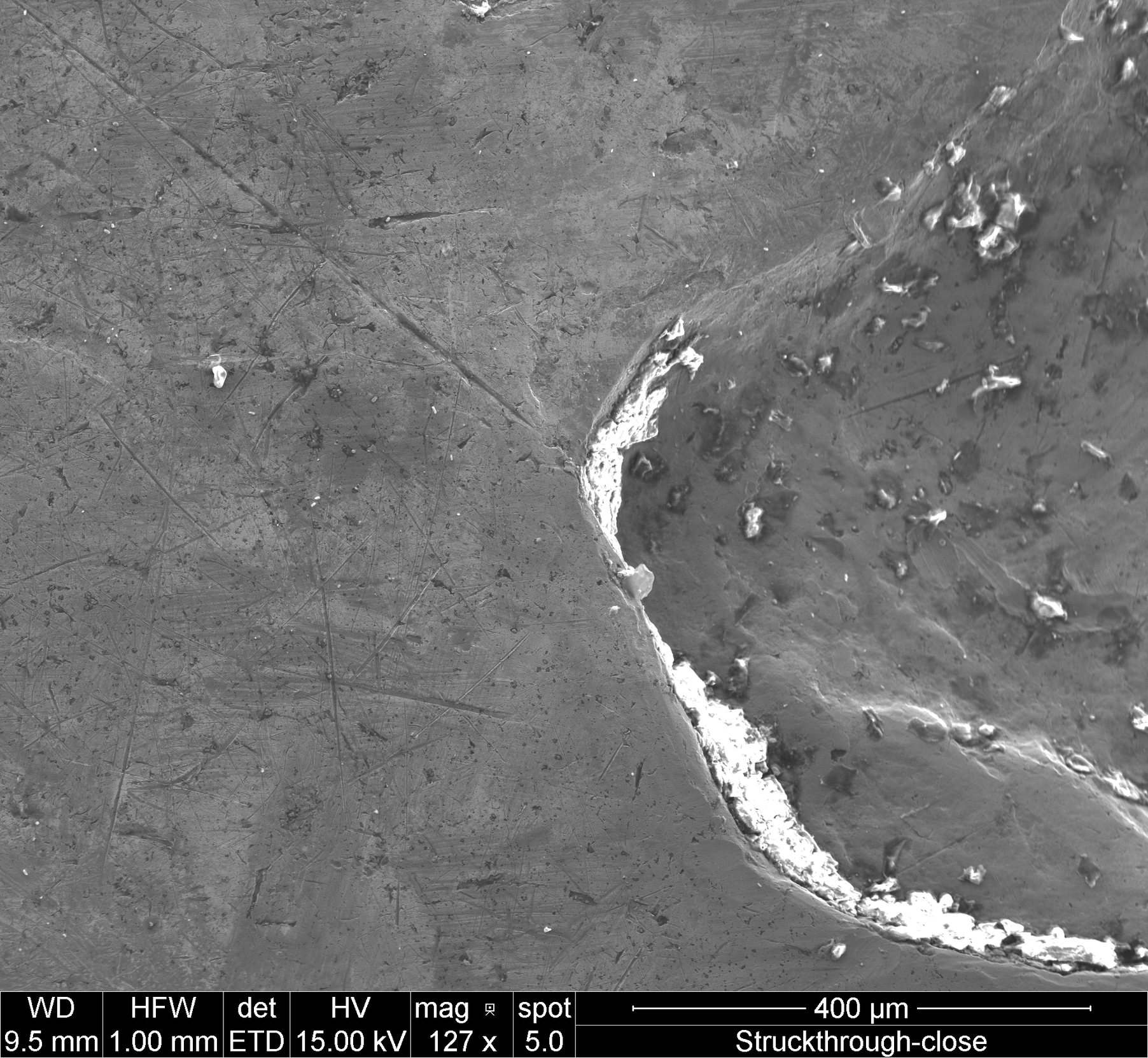
@jrm.... Welcome aboard....Very interesting pictures. In hand, we see a smooth, shiny metal.... Under this magnification it resembles a barren landscape....What is the subject of your book?? Cheers, RickO
nice and welcome to the boards
it has been said that cartwheel luster is a result of metal flow during the coining process. 1500x will help show if this does occur.
Sounds like a very nice thread that will actually teach us something.
Thanks
OK, time to look at the full reverse of this coin and the reverse die that made it. There are a couple of presumptions that I would like to assert in order to discuss it but will save the details for the discussion of the obverse die. Here they are: The obverse die was new, just pulled from the box from Philadelphia where it was made and installed just prior to the striking of this coin, and, The obverse die was miss-made, having additional mass in the area corresponding to the reverse die failure. This is all that I want to say about the obverse die until we turn that page. Please accept these assertions for the discussions sake at this point. As for the full reverse you can see many struck through objects which are fragments of the reverse die itself. There is an area of the coin (upper left quadrant) that took far more pressure than the rest of the coin as the dies bottomed out hard against each other through the coin in this area. I've found no precedent for such a large central die failure in modern coins, but you wouldn't expect to find one as modern dies are so well engineered that failures are almost always small die cracks or small chips off of the edges that produce cuds. In order to find large central die failures I had to look all the way back to ancient coins when dies were not well engineered and failures of all types were the norm. In ancients I was able to find similar failures. If you look at the upper left quadrant of the coin where the hard strike is, you can see that the overpressure in that specific area prevented the rim from being fully struck. All of the forensic evidence on the reverse combined with the knowledge that the obverse die was bran new leads to the ability to discern what coin this is in the sequence of coins struck by these dies. The reverse die has already been damaged and there are struck through bits, so this is not the first coin struck. The struck through pieces would be free to jump around on the reverse (anvil) die after each coin was struck. As these struck through bits moved to a new location they would reveal dents left in the die itself that would then be transferred onto the next coin struck as raised bumps on the coin surface. There are no bumps on this coin's surface so I believe that it is reasonable to assume that this was the second coin struck in what would be a very short series before the reverse die failure progressed to the point that coins began to become dish shaped and not flat as a result of lacking support for the planchet in this upper left quadrant. The reverse design probably turned to mush quite quickly. As you debate these ideas internally don't forget to look back at those first micrographs and what they represent. As you inspect the unstruck surfaces notice that they are surrounded and held in place by design elements, the wavy edge of a leaf and such. Any post mint tinkering leaves a rounded edge with a ramp up to the flat twice compressed area and you will see none of that here. This dime is a 1973D. It only gets stranger from here, so hold on tight.
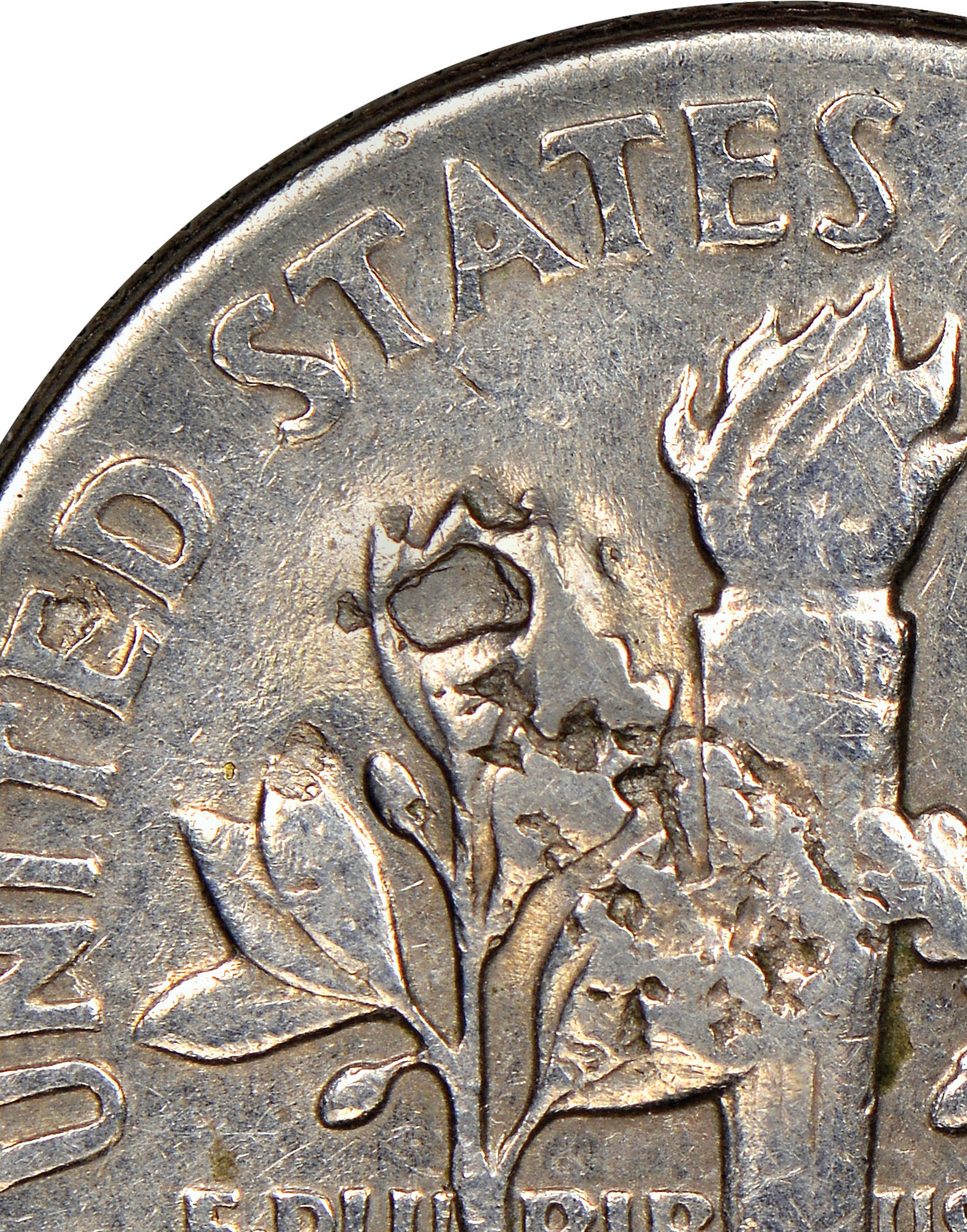
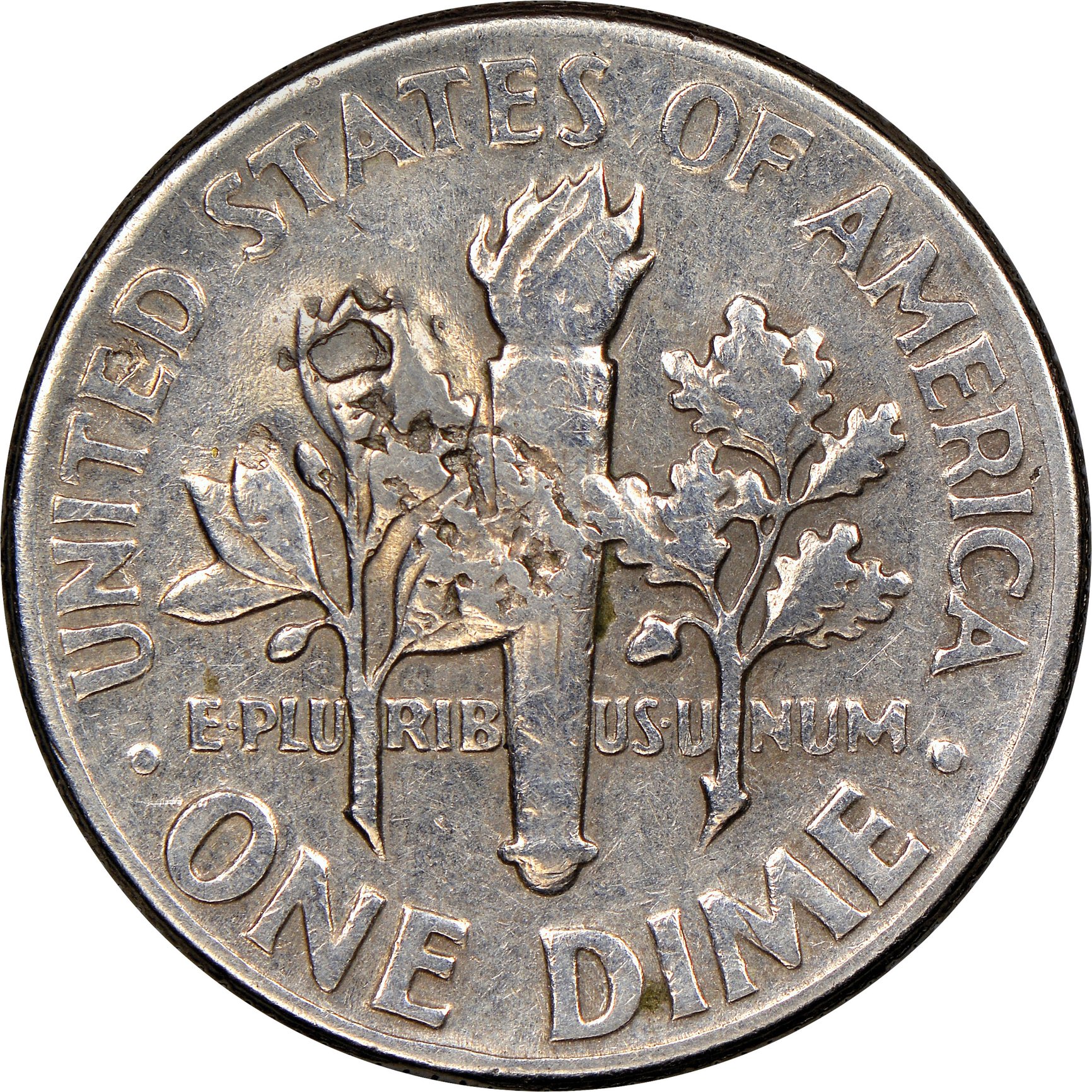
While this is all interesting, if you really want to make an educational post and have a SEM at your disposal, find a cheap, lustrous, uncirculated coin and photograph the flow lines that make up the luster at 1500x or higher. Then bake some toning onto it and photograph the same flow lines. Then dip the toning off and do it again. Lather, rinse, repeat until the coin is dipped out. That will become the definitive visual explanation for what overdipping does to luster.
Keeper of the VAM Catalog • Professional Coin Imaging • Prime Number Set • World Coins in Early America • British Trade Dollars • Variety Attribution
messydesk, I wouldn't say that I have an SEM at my disposal. I went to a local college found a professor willing to spend a few hours with me helping with my project. You may want to try your local university and see if you can pull off the luster experiment that you're interested in.
OP. Welcome to the forum. If you stick around, I believe your access to an SEM will provide all of us a very different look at coins. Unfortunately, I fear you have shown a lack of basic numismatic knowledge. The dime is severely damaged - that's all.
I tell my students we can PROPERLY dip an original coin once and no one can tell. We can do it again and again with the same results and no one can tell BUT **somewhere between the "X"th time we dip it and "Z" th time when the coin and our fingers dissolve (OUCH!), we can tell a coin has been over dipped!
Note: All bets are off when a coin has any environmental damage/toning that has altered its surface. Usually, these coins can be detected INSTANTLY using florescent light and a stereomicroscope.
Funny story: Back in the 1980's a famous numismatist came into my class as a guest and told the students he could put a light meter on a coin to get a reading and then dip the coin and get a different reading on the meter. OMG! As soon as he was gone, I joked to my class that a cloud must have blocked the sun if he actually ever tried that experiment. LOL.
Now, don't believe anything you read here. Go prove it for yourselves.
Insider2, the image that you've called the surface of an unoriginal damaged coin was taken in the field of the reverse in a normally struck area. The other much more coarse surface at 1500x is original unstruck planchet surface. If you think that striking a design into the surface and then damaging it later would produce this... I'm not sure how to help. On another note, I think that your unwillingness to spend the forty-five seconds needed to read the thread before commenting demonstrates that your opinions have no validity in this instance. I would appreciate it if you deleted your comments, there is no need to duplicate my images or hijack this thread with ramblings about dipping coins. It is a disservice to anyone that might be interested in this topic. Thanks.
In an attempt to keep you around, I'm going to delete most of my replies to you specifically as you have asked.
For now, your "study" (which has GREAT POTENTIAL in the right hands using the "right" coins) ) comes across as an unlicensed, pre-teen who is given the keys to a Formula 1 race car (SEM) with the same expected unfortunate result.
PS I suggest you use undamaged coins. Also, my offer still holds. PM me with your address and I'll send you some neat stuff to keep if you'll image it for all of us. I see potential in your interest.
insider2 first things first, you must learn to read before commenting.
insider2> @jrm said:
@jrm are you saying the reverse surface of your dime looked that way when it left the mint???
Sunny,
Forty plus years ago I did everything you are attempting to do at GWU in DC. At that time, I became qualified to use their SEM and I too had the head of that department (who was also interested in coins) working with me. The difference between you and I - aside from decades of practical NUMISMATIC experience - is back then (1970's), I was one of the few top professional coin authenticators in the U.S! I actually knew what we were looking at using very high levels of magnification.
While I have not been near an electron microscope in 35 years (by circumstances - not by choice); the equipment may have changed over the years but the magnified surfaces of "vintage" coins has not. Therefore, I will factually say that you'll never, ever come close to seeing anything with your SEM on a vintage coin that I have not seen already - possibly before you were born!
As you posted, there is a lot of NONSENSE going around on the Internet. So again, I suggest you get a "clue" before embarrassing yourself in print.
BTW, I hope you continue using the SEM! That's because In the 1980's, I told a student (scientist) in my authentication class that there is no one on earth who has examined as many coins using a stereo microscope as I have. It's because I had a several year head start over other authenticators. That number has continued to increase. In the next breath, I told the scientist that if he started to examine coins from then on using his SEM, in a very short time, he could claim to have examined the most coins using an SEM. Then he would know more about what a genuine coin looked like than I ever would.
In the next breath, I told the scientist that if he started to examine coins from then on using his SEM, in a very short time, he could claim to have examined the most coins using an SEM. Then he would know more about what a genuine coin looked like than I ever would. 
Fact: If he or any professional authenticator (including me) would have continued to examined genuine coins forty years ago using an SEM, the deceptive counterfeits of today wouldn't fool any of us!
I've offered some suggestions and some help with your project. You can take it or leave it; however, your comments have convinced me to start posting here again. I love a good back-and-forth as that's how we learn new things.
Good Luck - really! I'm pretty sure we'll all enjoy your future images.
I'm pretty sure we'll all enjoy your future images.
Insider2, could explain your following statement? aren't excellent counterfeits made the same way as the mint made?
Fact: If he or any professional authenticator (including me) would have continued to examined genuine coins forty years ago using an SEM, the deceptive counterfeits of today wouldn't fool any of us!
Yes, But the answer is not that simple. In the 1960's (before my time) & 70's the first half-way deceptive counterfeit gold coins were coming into the country. They were fooling many professional at the time. Their alloy was a low fineness (very bad color) and the relief was mushy and micro-granular. Unfortunately, hardly anyone in the country was examining coins using a stereo microscope and florescent light as was done by Mint authenticator's. Back then, authentication was done using weight, measurement , and specific gravity. So these coins were very deceptive.
Finely, one of the top numismatic authenticator's at the time began to expose them and the counterfeit menace in the Numismatist magazine. Unfortunately, he was untrained and not very experienced. So, at the time, everyone believed his assessment that the fakes were cast counterfeits! What was actually going on was the counterfeiters did not know the process to correctly anneal, harden or make a steel die. Some actually were using the exact same presses used for our genuine coins at the time! They could not get the steel or pressure correct so their product did not resemble the genuine coins. After a few months of training by Hoskins - he was trained by Mint authenticators - it was very easy to detect these coins from a mile away. As a brash "rookie" with a year of experience, when a top authentication expert tried to "educate" me on counterfeit detection, I already had surpassed him by miles - just by actually examining genuine coins at the Certification Service with my scope. So whenthe started to pull coins out of his coin pocket, while still in 2X2's from about a foot away I told him he was showing me counterfeits! Their color was off. LOL. Needless to say, after less than a two minute sit down, my "education was abruptly ended." Later we discovered that many coins formerly consider to be counterfeits in his collection turned out to be genuine.
All thru the next forty years, the counterfeits continued to improve. The improvements usually happened in big jumps. We would spot some common characteristic "artifact" of the fakes (like wormy tool marks in the 70's) that made authentication a matter of a few seconds under the scope and then we would no longer find it on the newest fakes. Nevertheless, in the past there has ALWAYS been some microscopic-tell-tale defect including today. However, what took a short amount of time in the past is often taking a very much longer time.
As always, the best defense is to know what the genuine coin should look like. That's why a stereoscope is needed today and I wish I had continued to study coins using an SEM all these years. That's because I'll guarantee that a C/F will not look like a genuine coin at 200X.
Great reply@Oldhoopster . @jrm please don't jump the gun since members here are only trying to support and direct you to the correct path. Lets be clear on the source of the experiment first.

Hi TurboSnail, I fully understand that the coin that I have presented appears to not have come from the mint in it's current form, but that is exactly what I am proposing. This coin left the mint just as we see it. If you will take the time to examine the micrographs (especially the ones of the struck surface taken in the field and the raw unstruck surface) and read my explanations in full you may agree that the surface that I've claimed as unstruck is just that and not a surface that has been compressed twice. At any rate I hope that you will take the time to read and understand what's been presented. Just because something has not been seen before doesn't make it untrue. I will be happy to discuss any aspect of this coin's surface with you, please read all of my full description and study the images. I have done my homework. Thanks.
Where's the micrograph of a twice compressed coin?
All comments reflect the opinion of the author, even when irrefutably accurate.
There is a member of cointalk who took some really good SEM shots of coin surfaces which show what natural mint luster looks like at high magnification. I don't want to outright steal his pictures, but I will link you to the threads for comparison:
https://www.cointalk.com/threads/mystery-error.289452/
https://www.cointalk.com/threads/2009-lincoln-cent-boot-strap-die-break-error.289022/
@jrm said: "I fully understand that the coin that I have presented appears to not have come from the mint in it's . At any rate I hope that you will take the time to read and understand what's been presented. Just because something has not been seen before doesn't make it untrue. I will be happy to discuss any aspect of this coin's surface with you, please read all of my full description and study the images. I have done my homework.
In view of your "homework" and in an attempt to make what you are posting more believable, I think you should let us all know your qualifications. It appears that you are some kind of "expert" in some field or other. What is your book going to be about - Mint errors?
I've been trying really hard to imagine what would cause all that damage to the dime. All the things I come up with are not associated with the Mint. Perhaps you can tell us where in the city you came across this "interesting" specimen.
Thanks mynamespat, the image that you shared is of a planchet surface taken at twenty times magnification. Even at that low magnification you can see how rough the original surface was. If there were an image of that suface at the high magnification that I used you would see just what I presented as unstruck in the first images. It would be nice if you found an image of a planchet at that higher resolution. Thank you for contributing.
There isn't one, insider thinks that the micrographs that I first shared are of a twice compressed surface. He actually made that assertion about the micrograph that was taken in a normally struck area of the field.
Yes, but you then claimed that the micrograph was NOT twice compressed but unstruck. I have two issues with this:
You can't conclude that it is not double compressed if we have no comparative image. All you could conclude is that it is NOT the same as the struck obverse. How do you know that image isn't exactly what a struck coin that is then damaged by a Post-Mint encounter should look like?
Why is the "struck through" being talked about as "unstruck"? It is struck by a foreign object, but still struck.
All comments reflect the opinion of the author, even when irrefutably accurate.
jmlanzaf, hi there has not yet been any mention of the obverse. If you look at my two first micrographs one was taken from an area of the field and was properly struck, the second image of a much more coarse surface was taken from the area that I have called unstruck. By comparing the two you can see the difference between an area that has been compressed once, and an area that has not been compressed.
I posted NOTHING of the sort! I've NEVER heard the term "twice compressed surface!" I have no idea what that is - perhaps a coin struck twice?
What I did post was that your image was a damaged coin (PMD) and was not the result of anything between the coin and planchet (Struck Thru). Your images prove it. It also does not show a "die chip."
Of course, all of my posts are just opinions that will carry the same "weight" as yours as soon as you let us know your qualifications. I know I'm going to be impressed.
I'm a skeptic.You see, as a rookie professional authenticator, I quickly discovered that the internationally acclaimed "Ex-Pert" I had admired and saved everything he wrote about authentication turned out to be a very misguided and ignorant poor soul who was being lead astray by a scientist with an x-ray diffraction machine!
Notice how the metal has a flow? ...and this picture appears to be at 1000x magnification, right?
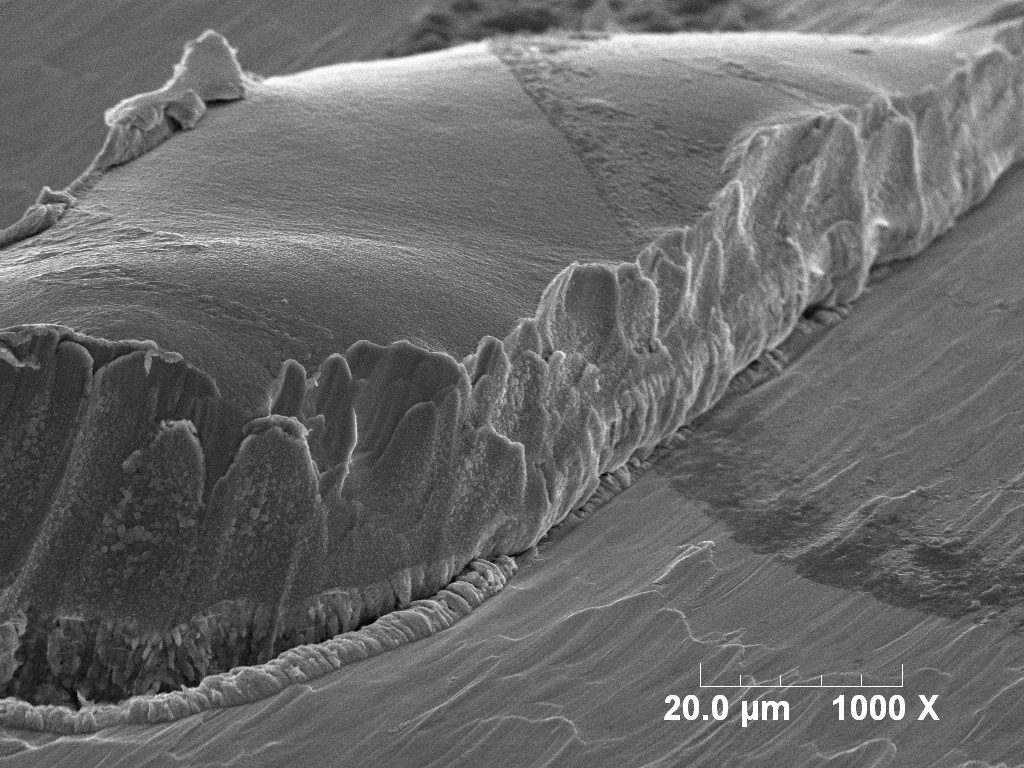
-https://www.cointalk.com/threads/2009-lincoln-cent-boot-strap-die-break-error.289022/
Your coin has none of that. It has, at the very least, been harshly cleaned.
??? While i understand that the surface of a planchet is compressed during the strike, please explain how the SURFACE of a coin that has been truck through something is NOT ALSO compressed by whatever the foreign material (the struck thru) was??? Although I've read your post six times, you are confusing me.
The SEM images from both of you are great to look at. Please keep them coming.
I think he was referring to the PMD as a "second compression".
All comments reflect the opinion of the author, even when irrefutably accurate.
mynamespat, That is a nice image of a die break but I'm confused as what you want to compare it to. The micrograph that I shared and called unstruck at 119x is probably the closest to it, but really not similar in angle or magnification. If you can find an image of a planchet taken at 1500x we would really have something to compare with my unstruck surface. I'm not sure why you would bring up cleaning as that is not the case. Look at the image of the entire reverse, does that look cleaned? Try to see the difference in the struck and unstruck images, cleaning has nothing to do with this. Post mint damage would represent the area being first properly struck (there is an image) and then compressed again by the post mint damage. The "unstruck" 1500x image does not show evidence of this, on the contrary it looks to clearly be what the struck surface would have looked like prior to being struck. Cheers.
IMO, I think that your "unstruck" area clearly looks like it has a lot of scratches and contact marks that would normally be found on on raised area of damage on a coin. If you're saying that these marks are leftover from the unstruck planchet, I think you're mistaken. You need to show that these marks are equivalent to an unstruck planchet and I see nothing in your posts that show this. You need more than a "trust me, my assumption is correct". You need more data to prove your conjecture.
Oldhopster, I think you are correct that taking the same images of a planchet would be quite useful. I also think that it will look just like my unstruck surface. Not having any luck just finding one on the internet so this may be something that I should work on. If I obtained a dime planchet, took scans and they were a match to my unstruck images would you agree that this coin came from the mint as we see it or would you have another problem with it?
The coin has been damaged, and its also cleaned, so the whole deal here is kinda null and void.
"It's like God, Family, Country, except Sticker, Plastic, Coin."
This should have been one of the key pieces of data in your study, not an afterthought. You are making claims that this coin was stuck using a reverse die that failed/collapsed in a very unusual way, yet offer no data to support that the "unstuck" area has even the slightest resemblance to an unstuck planchet.
Oldhoopster if I get a dime planchet, take images and they match the surface that I've called unstruck would that be enough for you to agree that the coin left the mint as we see it here? I just don't want to hunt down a planchet, get great matching images and then have you guys ask for something else. Getting these scans is not a simple task that I can just do whenever I want. So, would that be enough?
Why not send it to our host, PCGS, and see if it gets certified as a mint error?